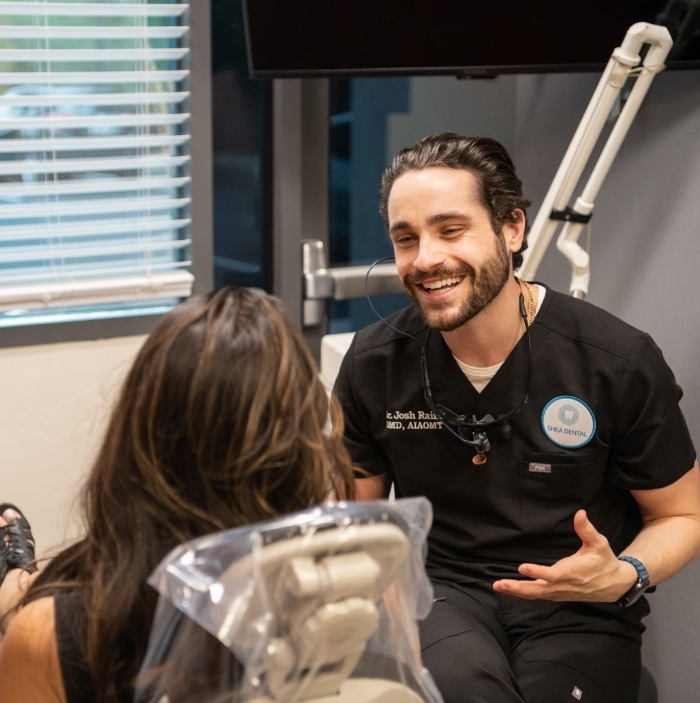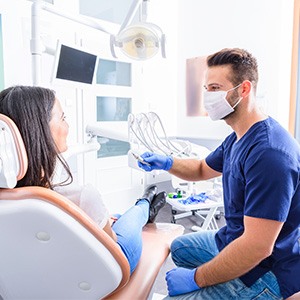Invisalign Clear Aligners – Scottsdale, AZ
Subtle Treatment Designed to Produce Straighter Teeth

Straighter smiles were once only achievable with the help of metal braces. Still used today by dentists and orthodontists alike, they remain one of the most popular methods of treatment. However, if you want a more subtle treatment that is designed to produce straighter teeth, allow us to present Invisalign clear aligners. Far more discreet than traditional braces, they make treatment easier to manage and more enjoyable. Call us to find out if you are a candidate for Invisalign in Scottsdale.
Why Choose Shea Dental of Scottsdale for Invisalign Clear Aligners?
- Team of Dentists Who are Patient-Focused
- Digital Impression System for Improved Patient Experience
- Caring, Dedicated Dental Team
How Invisalign Works
Invisalign uses a series of clear plastic aligners that are crafted to help your teeth shift into the desired position at various stages. Worn 20-22 hours each day, gentle pressure is continually applied to ensure that your teeth and bite move accordingly. After 1-2 weeks of wear, you are required to swap out your aligners for the next set in the series, allowing your smile to progress onto the next phase.
While no two treatment plans are the same, many patients can achieve results within 12-18 months. Depending on the severity of the problem (i.e., overcrowding, gapped teeth, or bite misalignment), the timeline for completion can vary.
The Benefits of Invisalign

The discreteness of clear aligner therapy, such as Invisalign, is the most obvious reason patients choose this type of orthodontic treatment. However, there are many additional benefits that you can expect should you opt for clear aligners, such as:
- The ability to eat all your favorite foods because Invisalign must be removed before eating or drinking.
- An easy-to-clean solution that doesn’t require special instruments, as there are no brackets or wires to clean around.
- Greater comfort because there are no protruding brackets and wires irritating your soft oral tissues.
- Faster results that can be achieved in 12-18 months as opposed to 2-3 years with metal braces.
Understanding the Cost of Invisalign

Although there are general price ranges available online, they are often misleading. After all, how can you provide information related to the cost without considering the factors that determine the answer, like how many aligners are needed? Rest assured, we will review all of the financial information with you at your consultation, including if your dental insurance will cover a portion of the cost of your orthodontic treatment. In the meantime, you can keep reading to learn more!
Factors That Affect the Cost of Invisalign

We mentioned above that there are several factors that impact the cost of your Invisalign treatment. At your consultation, we will learn about your smile goals, dental history, and oral health in order to determine important information like:
- How mild or severe your case is
- If rubber bands, buttons, or attachments are necessary
- How many aligners are needed
- The type of retainer you need
We will also share everything you need to know about staying on-track with your treatment plan in an effort to avoid delays and additional expenses down the line.
Invisalign vs. Mail-In Aligners: Which Costs More?

Have you seen commercials or ads on social media for mail-in aligners? Although the low upfront cost may draw you in, it’s important to consider how they achieve it. In other words, to cut costs, these alternatives aren’t overseen by licensed dental professionals, skip the initial assessment, and rely on DIY impressions. Furthermore, there is nowhere to turn if something goes wrong, which happens more often than you may think. So, while Invisalign requires a higher upfront investment, it’s reliable, effective, safe, and well worth your time and money.
Does Dental Insurance Cover Invisalign?

Dental insurance providers typically cover orthodontic treatments, including Invisalign, when “medically necessary.” So, don’t just assume that you’ll have to pay for clear aligner treatment out of pocket! Instead, take a look at your plan and, as always, let us know if you need any help! We are in-network with several major providers, and we can provide you with an estimate of your out-of-pocket expenses at your appointment.
Options for Making Invisalign Affordable

What if you don’t have dental insurance? The answer is easy: ask us about the financial solutions we offer! In addition to our Shea Dental of Scottsdale Membership Plan, which can help you save significantly on preventive and restorative care, we offer periodic specials to keep our patients’ out-of-pocket expenses to a minimum. Plus, we welcome payment plans with CareCredit, so you don’t have to pay for the entire cost of Invisalign at once. If you want to learn more, then don’t hesitate to give us a call to schedule your consultation!
Invisalign FAQs
What Do Invisalign Trays Look Like When Worn?
When worn, Invisalign trays appear clear and discreet, making them a popular choice for those seeking orthodontic treatment without the noticeable look of traditional braces. The trays are made from a smooth, transparent plastic that closely resembles the natural color of teeth.
When you wear them, they fit snugly over your teeth and may slightly alter the way your teeth look, but most people find them hard to notice from a distance. While they’re not completely invisible, their transparency allows them to blend in with your smile, making them a more aesthetically pleasing option.
Invisalign trays can also cause minor changes in speech initially, but most people adapt quickly. Regular wear (about 20-22 hours a day) is essential for effective treatment, and we will provide specific instructions on how to care for them to maintain clarity and hygiene throughout your treatment.
Can You Get Invisalign After Braces?
Yes, you can get Invisalign after completing orthodontic treatment with braces. Many people choose to use Invisalign for a few reasons, such as refining their smile or correcting minor misalignments that may have occurred after braces. This approach is often referred to as "comprehensive treatment" or "retreatment."
After braces, we will assess your teeth and jaw alignment to determine if Invisalign is a suitable option for you. The benefit of using Invisalign after braces is that it offers a discreet way to make adjustments, especially for adults or teens who prefer a less noticeable option.
It's important to maintain regular check-ups to ensure that any adjustments are effectively correcting your bite and alignment. In some cases, additional retainers may be recommended after treatment to maintain your results.
Can Invisalign Fix an Overbite?
Yes, Invisalign can effectively treat mild to moderate overbites. The clear aligners work by gradually shifting your teeth into better alignment, which can help correct the positioning of both the upper and lower teeth. During your treatment plan, we will design a series of custom aligners that apply specific pressure to your teeth, guiding them into the desired position over time.
For more severe overbites, Invisalign may be combined with other orthodontic treatments, such as elastics or even the use of traditional braces, to achieve the best results. It's essential to have a thorough evaluation to determine if your particular case can be effectively treated with Invisalign.
With regular wear and follow-up appointments, many patients see significant improvement in their bite and overall dental alignment, leading to a healthier and more aesthetically pleasing smile.
Can You Eat with Invisalign Trays In?
No, it’s not recommended to eat while wearing Invisalign trays. The trays are designed to fit snugly over your teeth, and eating with them in can damage the aligners, distort their shape, or lead to trapped food particles, which can affect oral hygiene.
We recommend removing the trays before meals or snacks. After eating, it’s essential to brush your teeth before putting the trays back in to avoid trapping food particles and bacteria against your teeth, which can lead to cavities and bad breath.
In general, it’s best to wear the aligners for about 20-22 hours a day for effective treatment, so remember to plan your meals accordingly to minimize the time your aligners are out.
Who is Not Eligible for Invisalign?
Although Invisalign is incredibly versatile, reliable, and effective, there are some patients who aren’t candidates. For example, children and young teens typically need traditional braces instead because they don’t have all of their permanent teeth. Clear aligner treatment also isn’t ideal for patients who consistently misplace things, who are struggling with severe misalignment, or who use tobacco products.
What Should I Do if My Invisalign Tray Broke?
If one of your Invisalign aligners broke, do NOT use superglue to try and repair them or move on to the next set in the series without consulting us. Instead, give our Scottsdale dental team a call so we can see where you are in the teeth-straightening process and determine the best way to proceed. If you only had a day or two left wearing that aligner, then we will likely recommend moving to the next set a bit early. If you just started, on the other hand, then we will ask you to wear the previous set while a replacement is made.
How Do I Clean My Invisalign?
You only need a few things to keep your Invisalign aligners stain and odor-free: clean water, a soft-bristled toothbrush, and clear, mild dishwashing liquid. You can also use the cleaning crystals that came in your welcome kit, especially if you need to wear your trays longer than you anticipated.
Important note: Do NOT use bleach to clean your aligners (it contains toxins that are not safe to ingest). It’s also important that you don’t use hot water since the high temperature can cause the plastic to warp, negatively impacting how your trays fit.
Will I Need to Wear a Retainer After Invisalign Treatment?
Yes, you will! In fact, your retainer plays a crucial role in preventing orthodontic relapse, which is the phenomenon when your teeth begin to move back into their previously misaligned positions. To put it simply, if you want to enjoy your hard-earned results for years to come, you need to wear your retainer as directed.
Does Invisalign Hurt?
To be honest, slight soreness is to be expected as your teeth move into their properly aligned positions. That said, Invisalign is considerably more comfortable than traditional braces because the aligners are metal-free, crafted from smooth plastic, and custom-made for each patient. Plus, any discomfort that does arise can easily be alleviated with the right steps, like sticking to soft foods, using a cold compress, and sipping on cold water.
How Long Does Invisalign Take?
The average treatment timeline with Invisalign is only 12 to 18 months! Of course, your journey to a straighter smile could fall outside of that timeframe; it depends largely on the severity of your case. The good news is that we can provide you with an estimate at your consultation, and we can also share what to do to prevent treatment plan delays, like wearing your aligners for 20 hours a day, every day.
 (480) 998-3923
(480) 998-3923